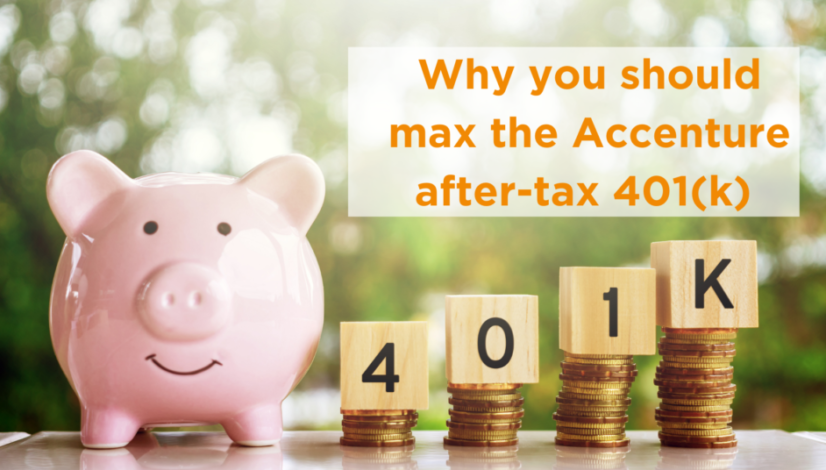Have you maxed out your Accenture after-tax 401(k) yet?
If you’re new you have an excuse; otherwise… how many times do I have to tell you about this wonderful opportunity??
Just kidding, this fantastic investment option may not be suitable for you, and this post isn’t a recommendation for your specific situation. Some people love paying as much in taxes as possible ;).
Read on if you’re interested in possibly saving hundreds of thousands of dollars in taxes.
What is the Accenture after-tax 401(k)
You might think you’re maxing out your 401k because you’re contributing the entire $22,500, or $30,000 if over age 50.
However, you can contribute on top of this amount. The IRS limits total 401(k) contributions to $66,000 in 2023 ($73,500 if 50+), but companies can set their own lower maximums.
Accenture allows you to contribute an additional $20,000 per year on top of your 401(k) or Roth 401(k) option. This “after-tax” contribution sacrifices tax benefits today for major benefits in the future.
The after-tax 401(k) becomes magical when you take full advantage of it by converting the contributions to a Roth 401(k). Accenture’s plan allows you to do this up to four times per year.
If you don’t convert to a Roth, your initial contribution is tax-free, but all your earnings are taxed later. However, when you convert the funds, all of your earnings become tax-free as well!
I’ve covered all the details on how the Accenture after-tax 401(k) works, but now I want to get into why it’s so magical.
Why the after-tax 401(k) is so magical
The good news is you’re a high earner as a Managing Director. The bad news is you pay for it in taxes, and you have fewer retirement account options at your disposal.
You make too much to contribute to a regular Roth IRA, and your tax bracket is too high to want to do a Roth conversion.
However, you are allowed to make a “backdoor Roth contribution” through a nondeductible IRA, or a “mega backdoor Roth contribution” through the after-tax 401(k).
Just know that any earnings that build within the after-tax account before conversion will be taxed as income when converted.
Running the numbers
Let’s get into the details of how this investment can be advantageous for you.
Scenario A: Sunil contributes $20,000 per year into the after-tax option for twenty years
Sunil made a great mid-career decision to start contributing to the after-tax 401(k). In his twenty years, he contributed $20,000 each year, and his investment return averaged 8% per year.
At the end of twenty years, Sunil’s account has amassed $915,239 of tax-free money. If Sunil didn’t convert to the Roth option each year, his $400k in contributions are tax-free, but he’d owe taxes on the $415,239 in earnings.
Scenario B: Laura learned early-on the advantage of the after-tax option, which she’s maxed out for 30 years
Laura’s head start in her after-tax contributions has allowed her account to reach $1.7M based on an 8% investment return!
If Laura didn’t convert to the Roth each year, her $450,000 in contributions are tax-free… but she’d owe taxes on the remaining $1.25M!
Can you see how powerful the conversions are now?
Tax Advantages of the conversion
You can see how advantageous the conversion can be as the examples above proved hundreds of thousands of tax-free dollars.
However, you don’t see the full advantages of the account and conversions until you look at how tax-free this money is.
When you start to remove money from a regular IRA or 401(k) penalty-free after age 60, this money counts as income. This has implications.
Not only are you taxed on this amount, but all additional income, including dividends and capital gains, stack on top. When you start receiving social security, it stacks as well.
These higher income amounts will have implications on how much of your social security is taxed, and you’ll pay higher Medicare premiums (IRMAA), as much as $500 per person ($1,000 per couple) per month!
Additionally, when you reach age 72 and start required minimum distributions (RMDs) from your IRAs/401(k)s, this also stacks on top!

Now, where the magic comes in: the funds in your Roth IRA accounts don’t stack! You could take the entire amount out anytime after age 60 (as long as you’ve had the account for at least five years) with ZERO tax consequences!
This opens up a world of possibilities, especially if you reach financial independence and decide to retire in your early 60s. You could live off your Roth account, tax-free, while converting your IRA funds into the Roth account for later!
Another advantage of the Roth account is for estate planning. Your heirs won’t have to pay taxes on inherited Roth IRAs like they will for an IRA inheritance.
You might be far away from having to worry about this at age 66 or age 72, but you have to plan now to optimize your tax situation.
That’s a lot to unpack, but I hope you see why the after-tax option can be so valuable. Feel free to schedule a consultation with me if you want to discuss further.
One big downside is the negative impact on your current cash flow. The money comes out after-tax, just as it does with VEIP contributions, making your first year as an MD even more difficult.
Still, as soon as you can get your cash flow figured out through selling VEIP shares or using additional savings, you should pursue the after-tax 401(k) option.

